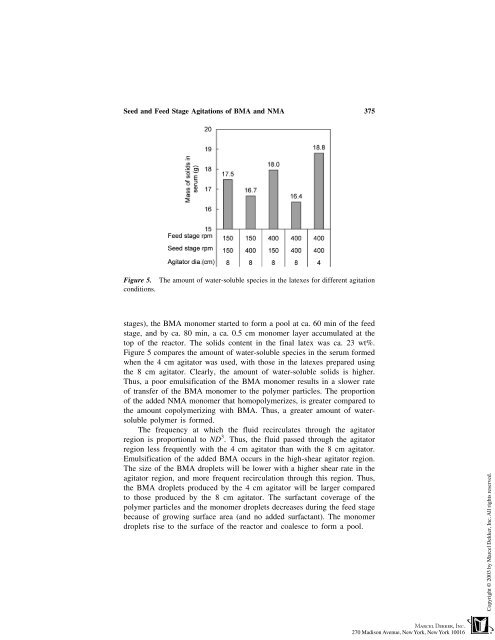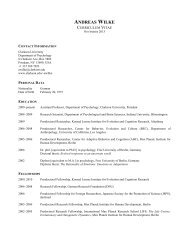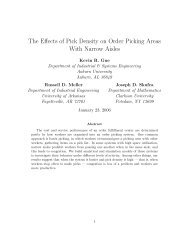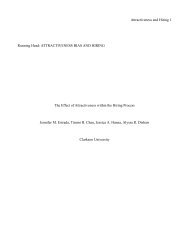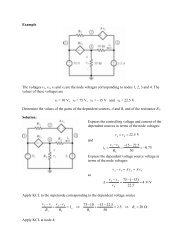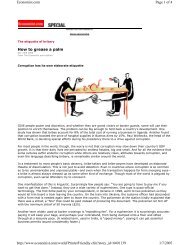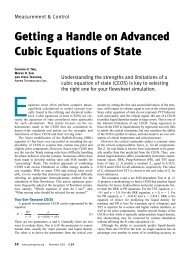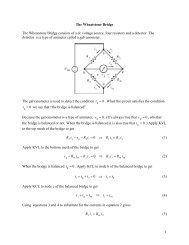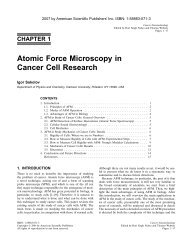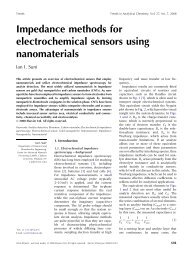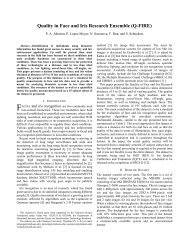Relative Importance of the Effects of Seed and Feed Stage ...
Relative Importance of the Effects of Seed and Feed Stage ...
Relative Importance of the Effects of Seed and Feed Stage ...
You also want an ePaper? Increase the reach of your titles
YUMPU automatically turns print PDFs into web optimized ePapers that Google loves.
<strong>Seed</strong> <strong>and</strong> <strong>Feed</strong> <strong>Stage</strong> Agitations <strong>of</strong> BMA <strong>and</strong> NMA 375<br />
Figure 5.<br />
conditions.<br />
The amount <strong>of</strong> water-soluble species in <strong>the</strong> latexes for different agitation<br />
stages), <strong>the</strong> BMA monomer started to form a pool at ca. 60 min <strong>of</strong> <strong>the</strong> feed<br />
stage, <strong>and</strong> by ca. 80 min, a ca. 0.5 cm monomer layer accumulated at <strong>the</strong><br />
top <strong>of</strong> <strong>the</strong> reactor. The solids content in <strong>the</strong> final latex was ca. 23 wt%.<br />
Figure 5 compares <strong>the</strong> amount <strong>of</strong> water-soluble species in <strong>the</strong> serum formed<br />
when <strong>the</strong> 4 cm agitator was used, with those in <strong>the</strong> latexes prepared using<br />
<strong>the</strong> 8 cm agitator. Clearly, <strong>the</strong> amount <strong>of</strong> water-soluble solids is higher.<br />
Thus, a poor emulsification <strong>of</strong> <strong>the</strong> BMA monomer results in a slower rate<br />
<strong>of</strong> transfer <strong>of</strong> <strong>the</strong> BMA monomer to <strong>the</strong> polymer particles. The proportion<br />
<strong>of</strong> <strong>the</strong> added NMA monomer that homopolymerizes, is greater compared to<br />
<strong>the</strong> amount copolymerizing with BMA. Thus, a greater amount <strong>of</strong> watersoluble<br />
polymer is formed.<br />
The frequency at which <strong>the</strong> fluid recirculates through <strong>the</strong> agitator<br />
region is proportional to ND 3 . Thus, <strong>the</strong> fluid passed through <strong>the</strong> agitator<br />
region less frequently with <strong>the</strong> 4 cm agitator than with <strong>the</strong> 8 cm agitator.<br />
Emulsification <strong>of</strong> <strong>the</strong> added BMA occurs in <strong>the</strong> high-shear agitator region.<br />
The size <strong>of</strong> <strong>the</strong> BMA droplets will be lower with a higher shear rate in <strong>the</strong><br />
agitator region, <strong>and</strong> more frequent recirculation through this region. Thus,<br />
<strong>the</strong> BMA droplets produced by <strong>the</strong> 4 cm agitator will be larger compared<br />
to those produced by <strong>the</strong> 8 cm agitator. The surfactant coverage <strong>of</strong> <strong>the</strong><br />
polymer particles <strong>and</strong> <strong>the</strong> monomer droplets decreases during <strong>the</strong> feed stage<br />
because <strong>of</strong> growing surface area (<strong>and</strong> no added surfactant). The monomer<br />
droplets rise to <strong>the</strong> surface <strong>of</strong> <strong>the</strong> reactor <strong>and</strong> coalesce to form a pool.


